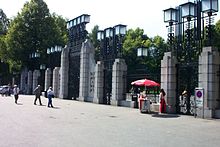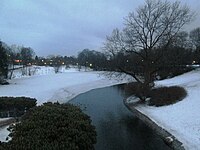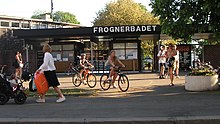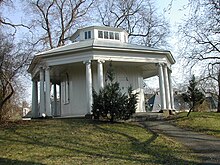Норвегия представляется холодной страной с чарующими видами и скандинавским колоритом. Страна фьордов и троллей, гор и водопадов. Туристы со всего мира приезжают сюда за пейзажами, свежим воздухом и, конечно, впечатлениями. Большинство туристов начинают знакомство со столицы – Осло. Именно там и находится самая неоднозначная достопримечательность всей Скандинавии – парк скульптур Вигеланда.
Редкий турист, посетивший Осло, обойдет его стороной. Ведь это крупнейший и интереснейший парк Норвегии. У большинства, посетивших это место, остаются неоднозначные впечатления. И неудивительно, ведь скульптурный комплекс, представляющий эпоху Третьего Рейха, видишь не каждый день.
Источник: https://kuku.travel/country/norvegiya/goroda-i-kurorty-norvegiya/oslo/park-skulptur-v-oslo-grandioznoe-tvorenie-gustava-vigelanda/
Содержание
Главные ворота

Главные ворота (кованое железо и гранит) состоят из пяти больших ворот, двух маленьких для пешеходов и двух крытых медью контрольно-пропускных пунктов, украшенных флюгерами. Главные ворота были установлены в 1942 году на деньги Норвежского банка.
Источник: https://ru.wikipedia.org/wiki/%D0%9F%D0%B0%D1%80%D0%BA_%D1%81%D0%BA%D1%83%D0%BB%D1%8C%D0%BF%D1%82%D1%83%D1%80_%D0%92%D0%B8%D0%B3%D0%B5%D0%BB%D0%B0%D0%BD%D0%B4%D0%B0
Это интересно:
History

Frogner Park’s front gate



In the middle of the 18th century Hans Jacob Scheel, then owner of the Frogner Manor, laid out a baroque garden adjacent to his new manor house. It was expanded by the people who followed him, starting with Bernt Anker (1746–1805) who bought Frogner in 1790 and expanded the main building. Benjamin Wegner took over the property in 1836 and he transformed the garden into a romantic park around 1840. Later, most of the arable land was sold to private developers.
Around one square kilometer remained when the City of Oslo bought the property in 1896 to secure space for further urban development. The municipal government decided around 1900 to make a park for recreation and sports. Frogner Stadium was opened near the road and the area near the buildings was opened to the public in 1904. Norwegian architect Henrik Bull designed the grounds and some of the buildings erected in Frogner Park for the 1914 Jubilee Exhibition.
The municipal government subsequently decided that Gustav Vigeland’s fountain and all his monuments and statues should be placed in the park. The area was ready for Gustav Vigeland fountain in 1924 and the final plan was released in 1932 by the city-council. Most of the statues depict people engaging in various typically human pursuits, such as running, wrestling, dancing, hugging, holding hands and so on. However, Vigeland occasionally included some statues that are more abstract, including one statue, which shows an adult male, fighting off a horde of babies.
-

Industrialist Benjamin Wegner (owner of Frogner from 1836) transformed the garden into a romantic park around 1840
-

Landscape architect and city gardener Marius Røhne was a central person in the development of the park from the early 1900s
-

Sculptor Gustav Vigeland created the sculpture arrangement in the centre of the present enlarged park from the 1920s until his death in 1943
Источник: https://en.wikipedia.org/wiki/Frogner_Park
Мост
Пятьдесят восемь скульптур располагаются вдоль стометрового моста шириной 15 м от главных ворот до фонтана. Все эти бронзовые скульптуры соответствуют основному замыслу парка — «Человеческому темпераменту». Здесь посетители могут видеть одну из самых популярных фигур парка — «Сердитый малыш». В 1940 году мост стал первой частью парка, открытой для публики, в то время как большая часть парка всё ещё находилась в стадии реконструкции.
Источник: https://ru.wikipedia.org/wiki/%D0%9F%D0%B0%D1%80%D0%BA_%D1%81%D0%BA%D1%83%D0%BB%D1%8C%D0%BF%D1%82%D1%83%D1%80_%D0%92%D0%B8%D0%B3%D0%B5%D0%BB%D0%B0%D0%BD%D0%B4%D0%B0
поместье
В усадебные здания расположены в южной части парка. Здания в датском загородном доме стиле были построены в 1750 — х годах , когда Ганс Якоб Scheel взял на собственность. После Bernt Anker , который был самым богатым человеком в Норвегии, приняла имение в 1790 году, здания были продлены, и усадебный дом стал одним из самых важных мест встречи норвежского высшего общества . Они были перестроены снова промышленник Benjamin Вегнер , который стал владельцем в 1836 году и который переехал в башню к главному зданию.
Под Вегнер, некоторые окружающие здания были построены, в павильоне на соседней высоту «Utsikten» (The View) и кучера дома у главных ворот перед усадьбой. Павильон был свадебный подарок от Вегнер к своей жене Генриетте Зейлера , и была перенесена из Blaafarveværket в 1830 — х годах. Это классический восьмиугольный круглый храм с колоннадой . Потолок нарисованная копия в миниатюре купола Пантеона, Рим . В передней части главного здания также солнечные часы , построенные для Вегнер.
Сегодня здание усадьбы занимают Осло , Городской музей .
За пределами усадьбы зданий, есть также кафе открыто в 1918 году (Frogner Park Café) и ресторан был открыт в 1960 году ( Herregårdskroen , «The Manor House Restaurant»).
Источник: https://ru.qwe.wiki/wiki/Frogner_Park
Детская площадка
В конце моста находится детская площадка — группа из восьми бронзовых статуй, изображающих детей во время игры. В центре, на гранитной колонне, изображён зародыш.
Источник: https://ru.wikipedia.org/wiki/%D0%9F%D0%B0%D1%80%D0%BA_%D1%81%D0%BA%D1%83%D0%BB%D1%8C%D0%BF%D1%82%D1%83%D1%80_%D0%92%D0%B8%D0%B3%D0%B5%D0%BB%D0%B0%D0%BD%D0%B4%D0%B0
Это интересно:
Vigeland installation – the sculptures in Frogner Park
The Vigeland installation (Norwegian: Vigelandsanlegget), originally called the Tørtberg installation, is located in the present centre of Frogner Park. It is the name of the arrangement of sculptures and not of an area as such, as the entire park is called Frogner Park. The Vigeland installation in Frogner Park is sometimes incorrectly referred to as the «Vigeland Park,» but this name has no official status, is not commonly used in Oslo and is considered inaccurate. The legal name of the entire park in accordance with the Place Name Act (stadnamnlova) is Frognerparken (Frogner Park). The sculpture installation was, as part of Frogner Park, protected under the Heritage Act on 13 February 2009 under the name Frogner Park and the Vigeland installation (Norwegian: Frognerparken og Vigelandsanlegget).

The sculpture area in Frogner Park covers 80 acres (320,000 m2) and features 212 bronze and granite sculptures, all designed by Gustav Vigeland. The Bridge was the first part to be opened to the public, in 1940. The Bridge forms a 100 metre (328 ft)-long, 15 metre (49 ft)-wide connection between the Main Gate and the Fountain, lined with 58 sculptures, including one of the park’s more popular statues, Angry Boy (Sinnataggen). Visitors could enjoy the sculptures while most of the park was still under construction. At the end of the bridge lies the Children’s Playground, a collection of eight bronze statues showing children at play.
Most of the statues in the park are made of Iddefjord granite.
Originally designed to stand in Eidsvolls plass in front of the Parliament of Norway, the bronze Fountain (Fontenen) is adorned with 60 individual bronze reliefs, and is surrounded by an 1800 square metre black and white granite mosaic.
The Vigeland installation’s granite and wrought iron Main Gate also serves as the eastern entrance to Frogner Park from Kirkeveien. From there an 850 m (2,790 ft) long axis leads west through the Bridge to the Fountain and the Monolith, and ends with the Wheel of Life. The Main Gate consists of five large gates, two small pedestrian gates and two copper-roofed gate houses, both adorned with weather vanes. It was designed in 1926, redesigned in the 1930s and erected in 1942. It was financed by a Norwegian bank.
The Monolith Plateau is a platform in the north of Frogner Park made of steps that houses the Monolith totem itself. 36 figure groups reside on the elevation, representing a “circle of life” theme. Access to the Plateau is via eight wrought iron gates depicting human figures. The gates were designed between 1933 and 1937 and erected shortly after Vigeland died in 1943.
At the highest point in Frogner Park lies the park’s most popular attraction, the Monolith (Monolitten). The name derives from the Latin word monolithus, from the Greek μονόλιθος (monolithos), μόνος meaning «one» or «single» and λίθος «stone», and in this case is a genuine monolith, being fabricated from one piece of solid stone. Construction of the massive monument began in 1924 when Gustav Vigeland modelled it in clay in his studio in Frogner. The design process took ten months, and it is supposed that Vigeland used sketches drafted in 1919. A model was then cast in plaster.
In the autumn of 1927 a block of granite weighing several hundred tons was delivered to the park from a quarry in Halden. It was erected a year later and a wooden shed was built around it to keep out the elements. Vigeland’s plaster model was erected next to it for reference. Transferring the design began in 1929 and took three masons 14 years to accomplish. The Monolith was first shown to the public at Christmas 1944, and 180,000 people crowded into the wooden shed to get a close look at the creation. The shed was demolished shortly afterwards. The Monolith towers 14.12 metres (46.32 ft) high and is composed of 121 human figures rising towards the sky.
At the end of the installation’s axis there is a sundial, forged in 1930 (there is also an 1830s sundial outside the manor house in the south of the park), and finally the Wheel of Life stone sculpture, carved 1933–1934. The wheel depicts four adults, a child and a baby (the baby and child are on opposite sides).
The latest addition to the park is a statue titled Surprised (Overrasket), originally completed in plaster in 1942 only months before one of the models for the work, Austrian refugee Ruth Maier, was sent to Auschwitz and killed. A bronze cast made in 2002 is now installed in the park.
-

Frogner Park with the Vigeland installation seen in the centre
-

The monolith
-

Frogner Pond seen from the main bridge
-

Frogner park Pond during winter
-

The central bridge during winter
-

Frogner Park
Источник: https://en.wikipedia.org/wiki/Frogner_Park
Фонтан
Фонтан, изготовленный из бронзы и украшенный 60 отдельными бронзовыми скульптурами, по первоначальному замыслу должен был стоять перед зданием норвежского стортинга. Фонтан состоит из фигур людей разных возрастов и скелетов на ветвях гигантских деревьев. Идея композиции — за смертью следует новая жизнь. Дно фонтана выложено мозаикой из белого и чёрного гранита площадью 1800 м². Вигеланд работал над этим памятником с 1906 по 1943 год.
Источник: https://ru.wikipedia.org/wiki/%D0%9F%D0%B0%D1%80%D0%BA_%D1%81%D0%BA%D1%83%D0%BB%D1%8C%D0%BF%D1%82%D1%83%D1%80_%D0%92%D0%B8%D0%B3%D0%B5%D0%BB%D0%B0%D0%BD%D0%B4%D0%B0
Спорт и купания

На окраине Фрогнер парка Frognerbadet (Frogner ванны), который был открыт в 1956 году Старый Frogner стадион был открыт в 1901 году и был главной ареной города для катания . В 1914 году нынешний стадион Frogner был построен в непосредственной близости от старого стадиона. На месте старого стадиона Фрогнера, теперь есть теннисные корты .
Источник: https://ru.qwe.wiki/wiki/Frogner_Park
Плато «Монолит»

Плато «Монолит» — каменная платформа, окружённая ступенями, которая служит основанием для центрального сооружения парка — обелиска «Монолит», высеченного скульптором и бригадой камнерезов из огромной цельной глыбы. Тридцать шесть скульптурных групп людей располагаются на возвышении вокруг «Монолита» и символизируют «круговорот жизни».
Дорога к плато проходит через восемь фигурных ворот, сделанных из кованого железа. Ворота были спроектированы между 1933 и 1937 годами и установлены вскоре после смерти Вигеланда в 1943 году.
Источник: https://ru.wikipedia.org/wiki/%D0%9F%D0%B0%D1%80%D0%BA_%D1%81%D0%BA%D1%83%D0%BB%D1%8C%D0%BF%D1%82%D1%83%D1%80_%D0%92%D0%B8%D0%B3%D0%B5%D0%BB%D0%B0%D0%BD%D0%B4%D0%B0
В популярной культуре
- Книга Doomsday Key , написанная автором Джеймс Роллинс имеет сцены в Парк Frogner
- Норвежский фильм Эллинг есть сцена , в которой секс-одержимы Кьелл-Бьерн восхищается скульптуры парка с Эллинг.
- Научно — фантастический роман Mockymen по Ian Watson использует парк в качестве точки участка.
- Песня «Вигеланда Сон» «на Элеонор МакЭвого альбома s Out Там описывает прогулку в парке.
- Фантаст новелла Современное состояние по Иэн М Бэнкс включает в себя прогулку в парке на главных героев.
- В детективе Леопард , часть Гарри Hole серии, Фрогнер Парк является местом громкого дела об убийстве.
- В телесериале The Love Boat , некоторые из экипажа посетили и увидели скульптуры Вигеланда в Frogner Парк в два эпизода особенными.
- 2017 фильм Снеговик особенности сцены в парке.
Источник: https://ru.qwe.wiki/wiki/Frogner_Park
Колесо жизни
В конце 850 м продольных координат парка возведены солнечные часы, выкованные в 1930 году, и, наконец, «Колесо жизни», сделанное вручную в 1933—1934 годах. «Колесо» по форме напоминает венок из четырёх взрослых людей и ребёнка, бесконечно счастливых в своей гармонии. Этот символ вечности заключает в себе основную идею парка: путешествие человека от колыбели до погребения.
Источник: https://ru.wikipedia.org/wiki/%D0%9F%D0%B0%D1%80%D0%BA_%D1%81%D0%BA%D1%83%D0%BB%D1%8C%D0%BF%D1%82%D1%83%D1%80_%D0%92%D0%B8%D0%B3%D0%B5%D0%BB%D0%B0%D0%BD%D0%B4%D0%B0
Количество использованных доноров: 6
Информация по каждому донору:
- https://ru.wikipedia.org/wiki/%D0%9F%D0%B0%D1%80%D0%BA_%D1%81%D0%BA%D1%83%D0%BB%D1%8C%D0%BF%D1%82%D1%83%D1%80_%D0%92%D0%B8%D0%B3%D0%B5%D0%BB%D0%B0%D0%BD%D0%B4%D0%B0: использовано 6 блоков из 12, кол-во символов 2270 (10%)
- https://wikiway.com/norway/oslo/park-skulptur-vigelanda/: использовано 2 блоков из 6, кол-во символов 4093 (17%)
- https://kuku.travel/country/norvegiya/goroda-i-kurorty-norvegiya/oslo/park-skulptur-v-oslo-grandioznoe-tvorenie-gustava-vigelanda/: использовано 2 блоков из 3, кол-во символов 1601 (7%)
- https://ru.qwe.wiki/wiki/Frogner_Park: использовано 4 блоков из 9, кол-во символов 4409 (19%)
- https://tonkosti.ru/%D0%92%D0%B8%D0%B3%D0%B5%D0%BB%D0%B0%D0%BD%D0%B4-%D0%BF%D0%B0%D1%80%D0%BA: использовано 4 блоков из 5, кол-во символов 1990 (8%)
- https://en.wikipedia.org/wiki/Frogner_Park: использовано 5 блоков из 9, кол-во символов 9238 (39%)





